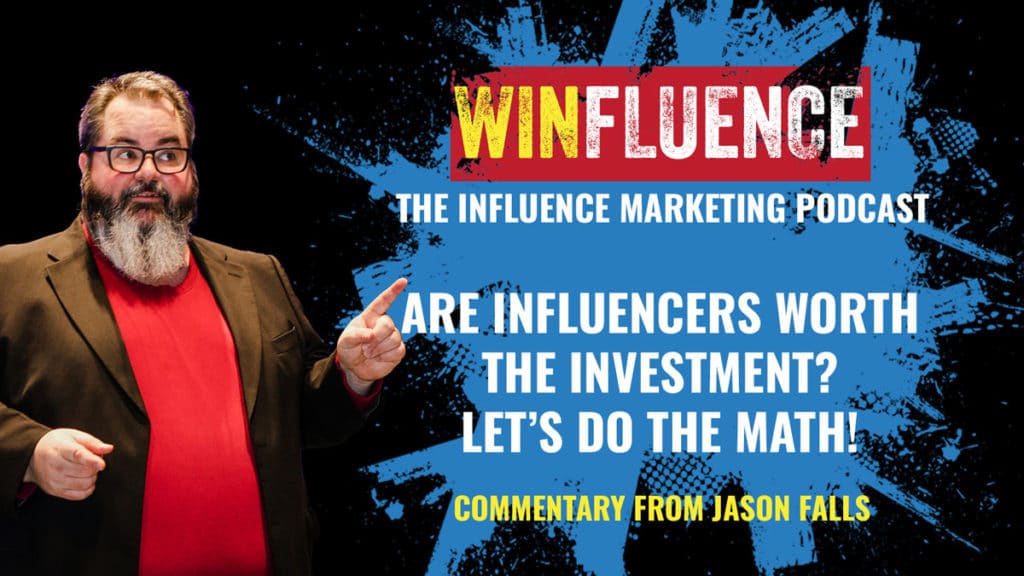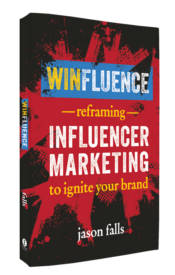Are influencers worth the rates they charge? Isn’t that the most frequently asked question among brand managers when it comes to influencer marketing these days? The answer, as always, is that it depends.
It depends on what they charge versus what the brand gets in return. Determining that depends on a variety of factors. How many followers does the influencer have. What’s their engagement rate, which indicates how many people actually interact with the content. What’s the conversion rate of those people to purchase the product in question?
And if you know all of those numbers, the answer of the influencer’s worth is still, “it depends.” Because you also need to know how much the average order value of this segment that converted was. Then you can compare the influencer’s rate to the financial return.

But even then, the answer is still “it depends” because one influencer program’s return might be fantastic margins for a low-margin company. That same number could be disaster for brands that typically have high margins.
And we’re just talking about transactional goals here. Influencers also bring content creation talent to the table, which is of value outside of any measure of their audience or conversions. You’d have to pay for that creative with a freelancer or internal employee’s time and resources otherwise.
Focusing however on the transactional goal — we want influencers to drive sales of our product — the financial equation is easy to understand, but often hard to implement. I’m going to break down the basics of the equation for you today using industry averages and standards so you at least have an idea of what an influencer costs versus what type of sales numbers you need for them to be worth the investment.
Let’s do some math today. And don’t worry, there’s a companion blog post at jasonfalls.co/influencermath that accompanies this episode. It has all this in writing, including a handy chart that visualizes what we’re about to go over.
A company called Intellifluence published it’s 2021 Influencer Compensation Report last week. The results were statistics compiled from a survey of 1,249 influencers in the United States, Canada and the United Kingdom from May. So this is current data and a healthy sample size.
According to the survey, influencers with 90,000 or more followers are paid an average of $1,221 per post across social networks. So, some might make more on Instagram, but less on Twitter and so on. That’s the average across networks.
The study breaks down the average cost per post for influencers with less than 90,000 followers in increments of 10,000 follower segments. So we know the average cost per post of someone with 80,000 to 89,999 followers, 70,000 to 79,999 and so on.
As you might expect the average cost per post drops with each 10,000 follower count. The 80,000-something influencers average $1,001 per post. The 40,000-something ones are at $518 per post and the 10,000-something ones are at $274 per post. The rest fall in between.
Using this pricing, a brand can expect to pay about 1 to 1 and ½ cents per follower for an influencer’s post. That’s at least a nice, even benchmark to think about.
How Many Followers Will Engage?
So, let’s look at influencers with 90,000 followers. It’ll cost me an average of $1,221 for them to post about my product. I know the average engagement rate on Instagram is 1.22%. That’s data from RivalIQ. Certainly, a given influencer’s engagement rate might be higher, or lower, but the average engagement rate across Instagram altogether, is 1.22%
We’ll use this Instagram metric as a baseline. I know the average number of followers is across all networks. And I know that engagement rates change per network, but for this exercise, play along.
That engagement rate means that of the influencer’s 90,000 followers, I can expect about 1,098 people will engage with the post. But how many of those people will actually click through and convert?

How Many Engaged Followers Will Convert?
Well, we don’t have a good standard metric of average conversions from social media content, so we’ll have to use a proxy. We do know that the average conversion rate for Google Adwords is 3.75%. That data comes from Unbounce.
Yes, ads and search ads are different than social media content, so this isn’t a perfect comparison. But let’s assume for the exercise that 3.75% is a reasonable conversion rate.
That means that of those 1,098 people that engage with the content, I can expect about 41 of them will purchase.
Note that I’m doing the 3.75% of those engaged, not the total number of followers. Why? Because those who are engaged are at least those who I know interact with the content at all. For all I know, the other 89,000 people never even saw it. I’m working with what I know.
And, it’s reasonable to say that only the people who engage with the content are likely to convert. Yes, the conversion rate may actually be higher than that of a Google Ad, but again, it’s what I can use as a reasonable proxy since I don’t know the average conversion rate of sales through social media channels.
So now I have a projected number of purchases. I also have the cost of the influencer’s post. Here’s where we get to do the important math.
If I take the cost of the post—$1,221—and I divide that by the number of projected sales—41—I learn that in order to break even on the deal, my average order value from those 41 purchases needs to be $30. If my profit point is 2.5 times my revenue, then my average order value must be at least $74.
When you do the math for an influencer in the 40,000-49,999 follower range, whose post costs $518, then 21 people will purchase, thus the average order value to break even is $25. The orders need to be $63 for the 2.5 times revenue for profitability.
Doing the math for the 10,000-19,999 follower range influencer: Their average post runs $274. The engagement and conversion math means that seven people will purchase. That means the break-even order value is $40 and the profitability order value must be $100.
Again, there’s a full chart so you can visualize this at jasonfalls.co/influencermath.
So, if I’m a brand and I invest in a post from an influencer with 90,000 or more followers, my average order value needs to be $30. If I sell $12 T-shirts, I’d better hope everyone buys three or my ROI will be negative.
Across the board, the average order value equation to just break even ranges from $24 to $40. The profitability level of the orders ranges from $59 to $100. I based that rate on 2.5 times the cost since that’s my broad understanding of a minimal level to account for overhead and such, to be profitable.
Let me be very clear: These are benchmarks based on the best guess we can make from the data we know. If an influencer’s engagement rate is well above 1.22 percent, then their math becomes more favorable and the order value can be lower.
If the average conversion rate of purchases from social media content is higher than the 3.75% from Google AdWords we used, then again, the influencer’s numbers are more favorable and the average order value needs can come down.
Then there’s the actual cost of a post. If it’s higher or lower, your AOV need will be higher or lower.
What This Means
Technically, these numbers don’t mean much. But they are a good benchmark for brands and influencers. If you’re a brand, you can look at the math and know that if the influencer costs around $1,000 for a post and your engagement rate is around 1.22% and your conversion rate winds up about 3.75%, your product needs to sell for $26 or more for you to break even. If any of those numbers are different, in your favor or not, you can plan accordingly.
If you’re an influencer, you now have the math to know you need your engagement rates to be higher than average, or your ability to convince your audience to convert needs to mean more than three percent actually do … or both.
But you also know that if the price of the item you’re endorsing is more than $100, those engagement and conversion rates can be of less concern.
It’s not the end-all, be-all to understanding your value as an influencer. The content you create, your feedback and relationship with the brand, your connection with your audience on the brands’ behalf and much more are incredibly valuable. But the math we used is often what your brand partners care about the most.
Knowing that makes you a more powerful and relevant partner for them. And you.
What are your thoughts about my crazy math exercise? Do you think differently about engagement rates now that you see how they can be used to determine an influencer’s monetary value? How much more … or how much less … than 3.75% do you think conversion rates are from an influencer’s social media posts? Would you do the math differently?
Record a voice memo and email it to [email protected] I may use your comments on a future episode.
Have a different question or topic related to influence or influence marketing you’d like my take on? Inspire an episode by emailing me at that same address [email protected]. I may use your question as a show topic. If I do, I’ll send you a signed copy of Winfluence the book as a thank you!
Today’s episode is sponsored by my friends at Tagger.
They reached out to me recently and asked me to give their influencer marketing platform a try. I set up a campaign with a client project and kicked the tires. I wasn’t sure an influencer marketing platform could really impress me much anymore, but boy was I wrong.
I was so impressed, I’ve switched to using Tagger for client projects.
Here’s what got me: I didn’t do a demo or training session. I just jumped in and tried to hunt and peck my way to figure it out. Within an hour, I had a campaign set up for a client, a campaign brief loaded, five influencers invited to authorize into the platform for automatic reporting, including Instagram Stories by the way, and two customized reports for my client. One for assessing influencers, the other for measuring the campaign’s success.
The client saw that report and said, “This is what I need to show to senior leadership!” I call that a win-win!
The drag and drop customizable reports took me about five minutes each to set up. And I can either create new ones for each client campaign, or I saved the first two as templates I can plug any client into.
We’ll be talking a lot more about Tagger in the weeks to come here on Winfluence. They’ve just built a better mousetrap. So I’m in.
You can see more at jasonfalls.co/tagger.
The Winfluence theme music is “One More Look” featuring Jacquire King and Stephan Sharp by The K Club found on Facebook Sound Collection.

Order Winfluence now!
Winfluence – Reframing Influencer Marketing to Ignite Your Brand is available now in paperback, Kindle/eBook and audio book formats. Get it in the medium of your choice on Amazon or get a special discount on the paperback version of the book by clicking the button below, buying on the Entrepreneur Press bookstore and using the discount code FALLS20. That earns you 20% off the retail price. Read and learn why we’ve been backed into a corner to think influencer marketing means Instagram and YouTube and how reframing it to be “influence” marketing makes us smarter marketers.


